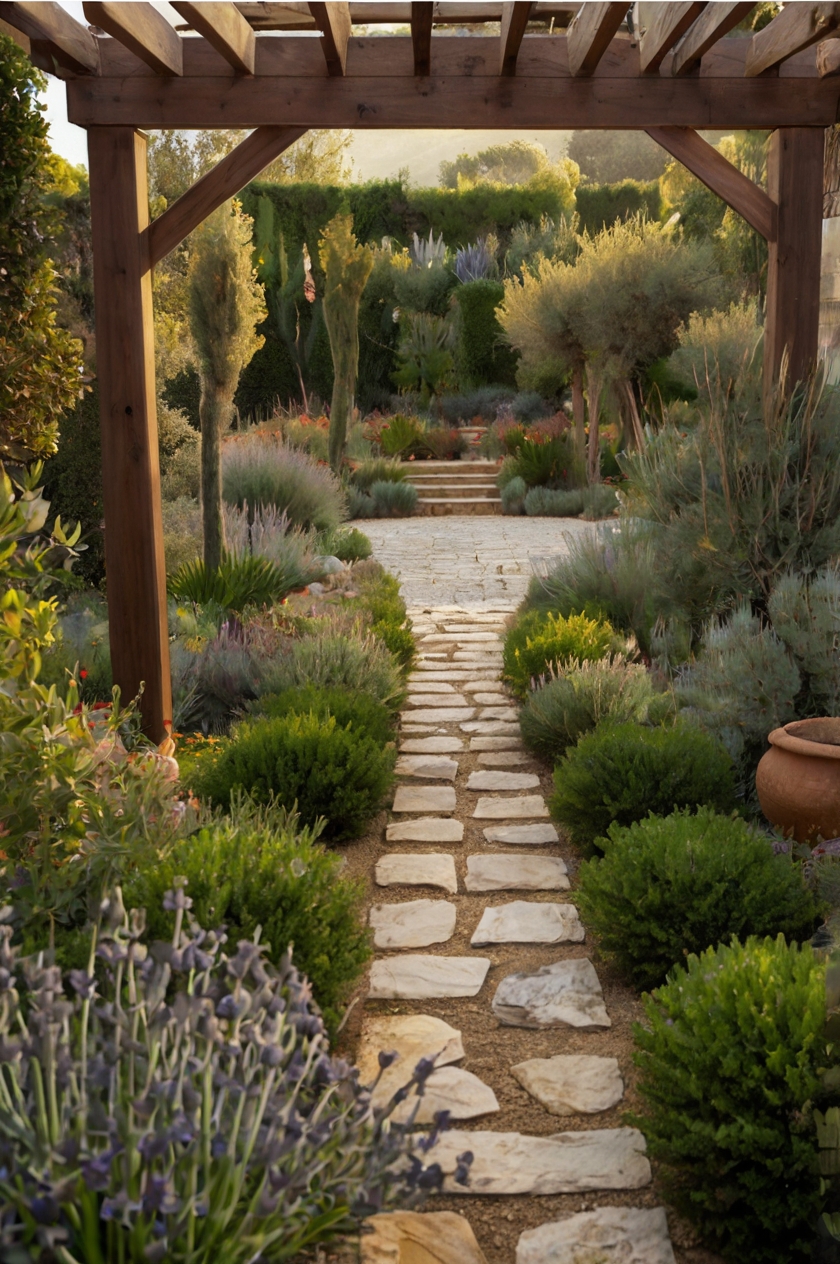Mediterranean gardens capture the essence of coastal European living with their sun-drenched patios, aromatic herbs, and timeless elegance.
These designs blend functionality with beauty, creating outdoor spaces that feel like permanent vacation destinations right in your backyard.
If you’re working with a sprawling lawn or a compact urban space, Mediterranean-inspired gardens offer endless possibilities for creating your own slice of paradise.
Create a Stunning Gravel Courtyard with Native Stone Accents
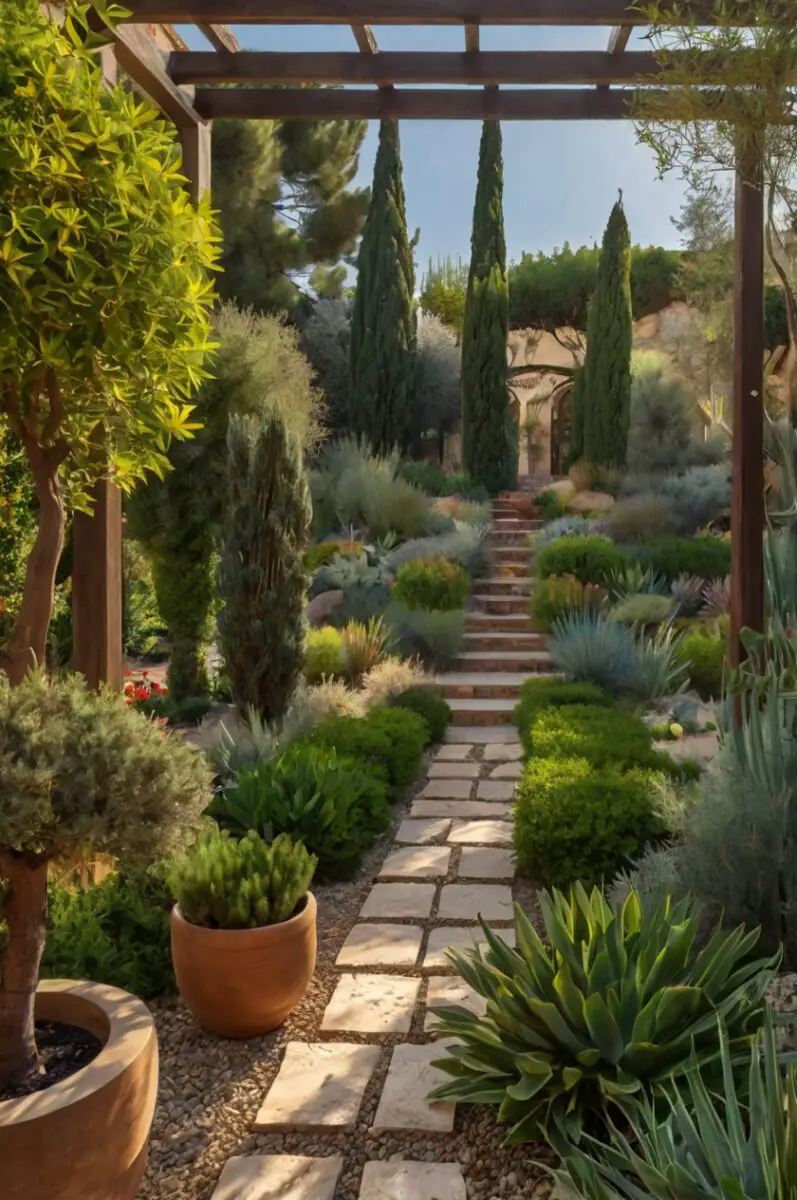
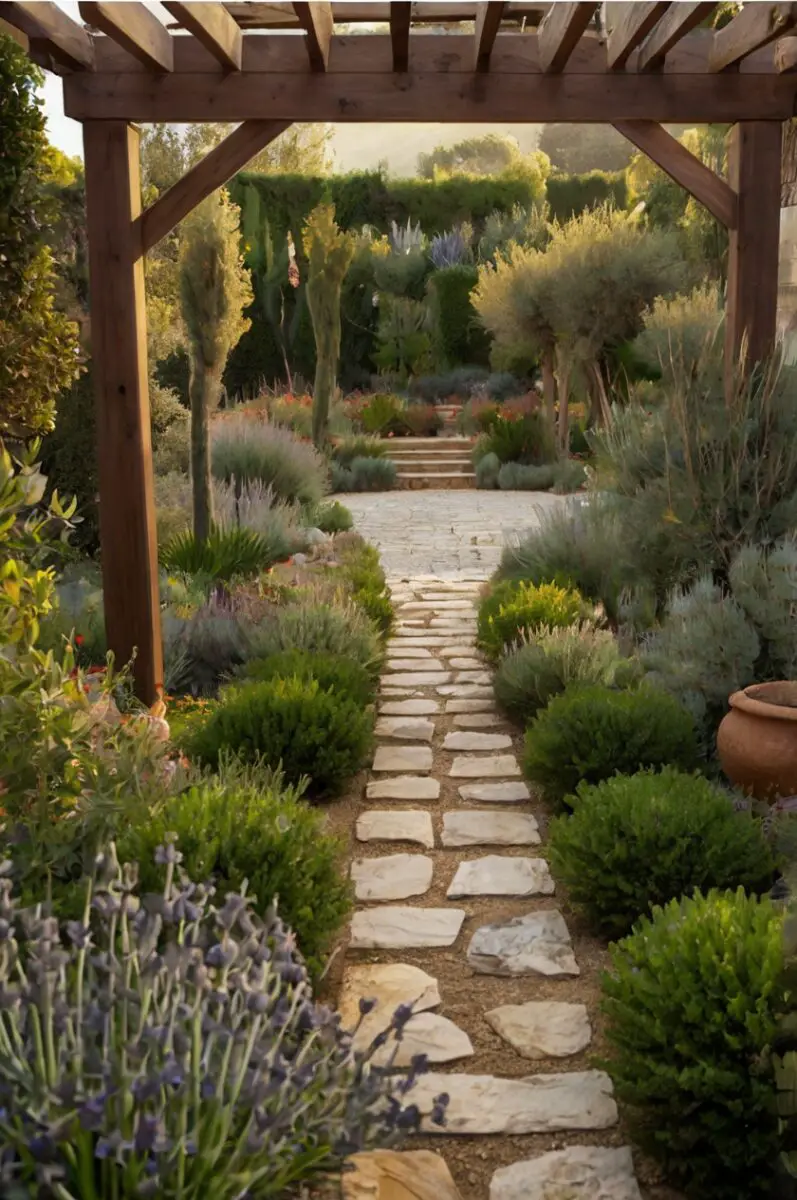
Nothing says Mediterranean quite like a beautifully designed gravel courtyard that serves as the heart of your outdoor living space.
Start by selecting warm-toned gravel in shades of cream, terracotta, or golden beige that complement your home’s exterior.
The key to achieving an authentic look lies in mixing different gravel sizes – combine larger pebbles with finer crushed stone to create visual texture and prevent that sterile, parking-lot appearance.
Edge your gravel areas with natural stone borders using limestone, travertine, or local fieldstone that adds instant character and prevents the gravel from migrating into planted areas.
Create defined pathways through your courtyard using larger stepping stones or flagstone pieces, spacing them naturally to encourage a leisurely stroll rather than a hurried walk.
Plant drought-tolerant perennials like lavender, rosemary, and ornamental grasses directly into the gravel – these plants actually thrive in the excellent drainage that gravel provides.
Add vertical interest with large terracotta urns filled with olive trees or citrus plants that can be moved indoors during colder months.
Install subtle LED lighting along the stone borders and beneath key plants to create magical evening ambiance that extends your outdoor enjoyment well into the night.
The beauty of a gravel courtyard lies in its low maintenance requirements – no mowing, minimal watering, and easy weed control.
Position comfortable outdoor furniture strategically throughout the space, choosing pieces in natural materials like teak or wrought iron that complement the Mediterranean aesthetic.
Add a central focal point such as a fountain, fire pit, or sculptural element that draws the eye and creates a gathering spot for family and friends.
TRENDING NOW
The Sauna & Hot Tub Fix Everyone’s Copying!Design an Aromatic Herb Spiral Garden
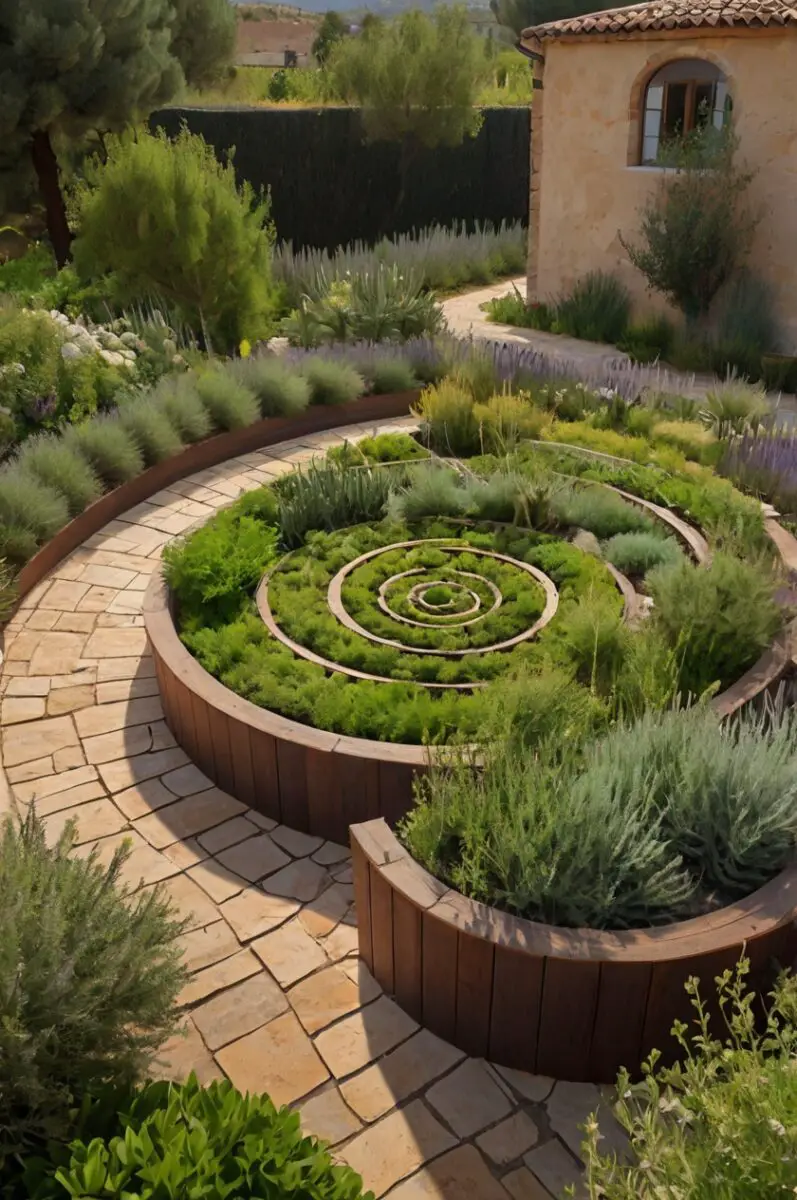
Transform a corner of your yard into a functional and beautiful herb spiral that brings the flavors of the Mediterranean directly to your kitchen.
Start by creating a spiral-shaped raised bed using natural stone, reclaimed brick, or concrete blocks arranged in a gradually ascending pattern from the outside edge to the center.
The spiral design maximizes growing space while creating different microclimates for various herbs – the top center stays drier and warmer, perfect for Mediterranean natives like oregano and thyme.
Plant sun-loving herbs such as rosemary, sage, and lavender at the top and along the sunny sides of your spiral where they’ll receive maximum exposure.
Position moisture-loving herbs like parsley, cilantro, and mint toward the bottom and shadier portions where they’ll benefit from slightly more retained moisture.
Create clear pathways between sections using small stones or mulch that allow easy access for harvesting without compacting the soil around your plants.
Install a simple drip irrigation system or soaker hoses throughout the spiral to ensure consistent watering while maintaining the excellent drainage these herbs require.
Add height and visual interest by incorporating taller herbs like bay laurel or fennel in the center, creating a natural focal point that draws attention to your edible landscape.
Surround the base of your herb spiral with decorative mulch or small stones that suppress weeds while maintaining the Mediterranean aesthetic.
Include aromatic flowers like nasturtiums or calendula throughout the spiral – these edible blooms add color while attracting beneficial pollinators to your garden.
Label each section with small stone markers or weatherproof tags to help you remember what you’ve planted and share knowledge with garden visitors.
Position your herb spiral near your kitchen or outdoor cooking area for convenient harvesting during meal preparation.
Design Your Dream Room in Minutes!
🏡 Start Creating FREE →Install a Rustic Pergola with Climbing Mediterranean Vines
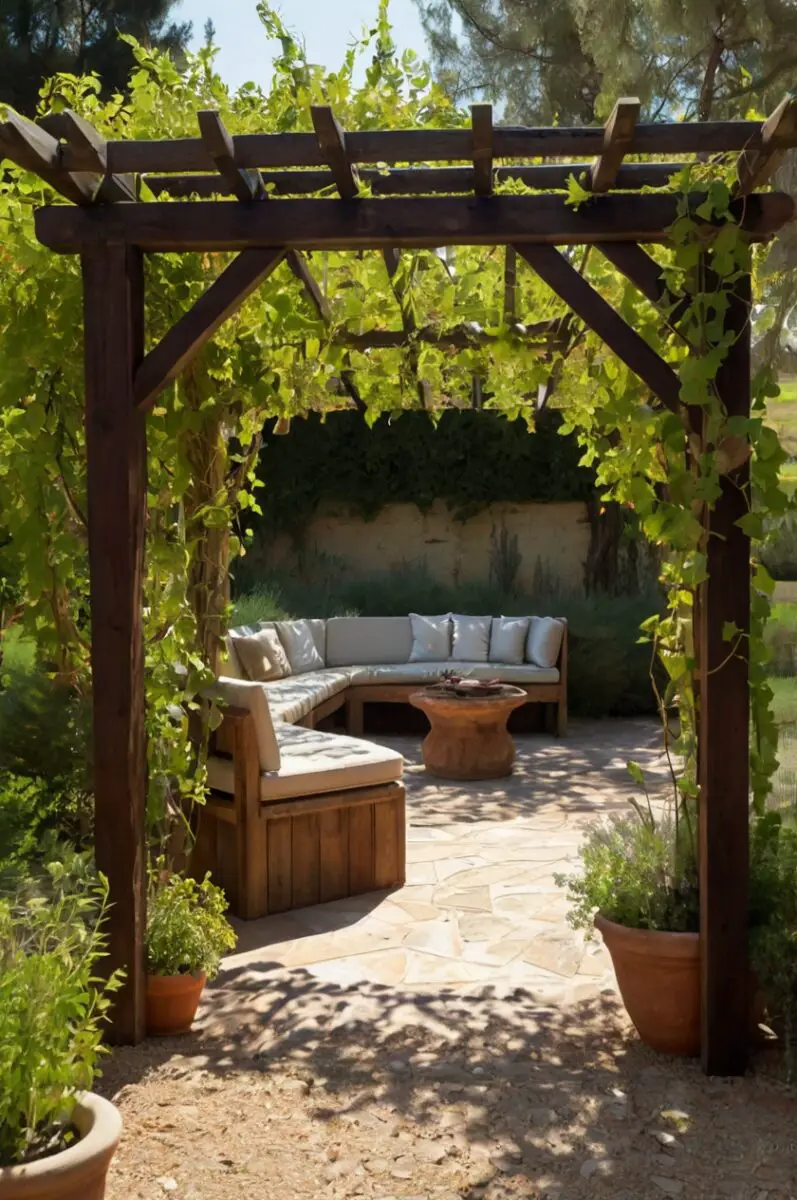
A well-designed pergola creates the perfect framework for Mediterranean climbing plants while providing essential shade and structure to your outdoor space.
Choose materials that reflect the rustic elegance of Mediterranean architecture – weathered cedar beams, reclaimed wood, or powder-coated aluminum that mimics aged metal.
Position your pergola to provide afternoon shade over seating areas, dining spaces, or pathways where relief from intense sun will be most appreciated.
Plant vigorous climbing vines at the base of each post, selecting varieties that thrive in Mediterranean climates and provide both beauty and function.
Grapevines offer the perfect combination of lush foliage, autumn color, and potentially edible fruit, though you’ll need to choose varieties suited to your specific climate zone.
Jasmine creates an incredibly fragrant canopy that perfumes your entire outdoor space during blooming season, though it requires regular pruning to prevent overgrowth.
Bougainvillea provides spectacular color displays in warm climates, with papery bracts in brilliant purples, pinks, and oranges that last for months.
Train your vines using galvanized wire or natural fiber rope stretched between the pergola beams, creating a grid pattern that supports growth while maintaining clean lines.
Install ceiling fans or misting systems within the pergola structure to enhance comfort during hot summer days without compromising the natural aesthetic.
Add outdoor curtains or roll-up screens to the sides of your pergola for additional privacy and wind protection when needed.
Position outdoor furniture beneath your pergola that complements the Mediterranean theme – wrought iron dining sets, comfortable lounge chairs, or built-in stone benches.
String warm white LED lights or lanterns throughout the pergola structure to create magical evening ambiance perfect for outdoor dining and entertaining.
TRENDING NOW
13 Boho Patio Ideas For Enchanting Outdoor SpacesBuild Terraced Planting Beds with Retaining Walls
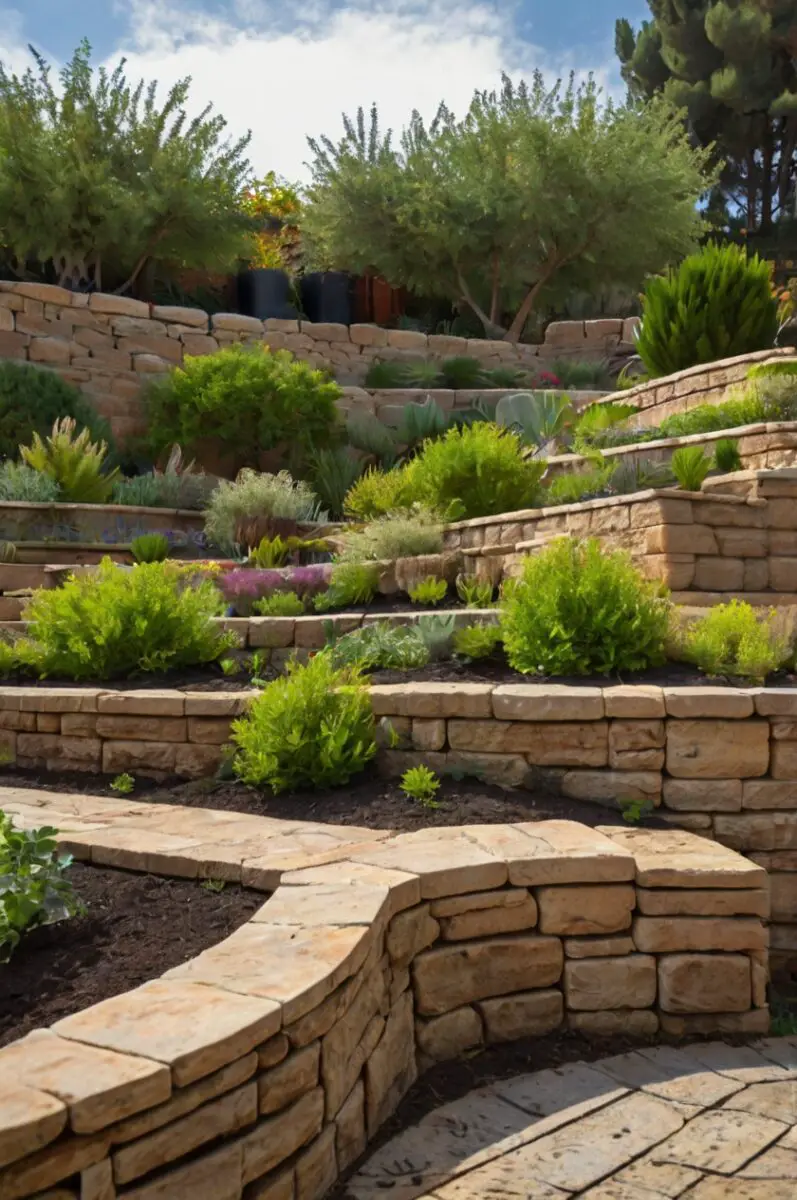
Terraced gardens maximize growing space while creating dramatic visual impact that’s quintessentially Mediterranean in style and function.
Start by assessing your slope and determining how many levels you’ll need – each terrace should be approximately 2-4 feet high for optimal plant growth and maintenance access.
Use natural stone, concrete blocks, or gabion walls filled with local stone to create sturdy retaining walls that complement your home’s architecture.
Install proper drainage behind each retaining wall using gravel, perforated pipe, and landscape fabric to prevent water buildup that could compromise structural integrity.
Fill each terrace with high-quality soil amended with compost and sand to ensure excellent drainage while providing necessary nutrients for plant growth.
Plant each level with appropriate vegetation based on exposure and drainage – drought-tolerant natives on upper terraces, and slightly more water-loving plants below.
Create wide pathways between terraces using flagstone, decomposed granite, or brick that provide safe access for maintenance and harvesting.
Install irrigation systems on each level, using drip lines or micro-sprinklers that deliver water efficiently without causing erosion.
Add architectural interest with different plantings on each level – perhaps ornamental grasses and wildflowers on top, vegetables and herbs in the middle, and shade plants below.
Include built-in seating areas within your terraces using stone benches or retaining wall caps that double as perches for enjoying your garden views.
Plant trailing varieties like rosemary, thyme, or trailing lavender along terrace edges where they can cascade over retaining walls for softening effect.
Position larger specimen plants like olive trees, citrus, or Mediterranean pines strategically throughout the terraces to create focal points and provide structure to the overall design.
Create a Stunning Water Feature with Natural Stone
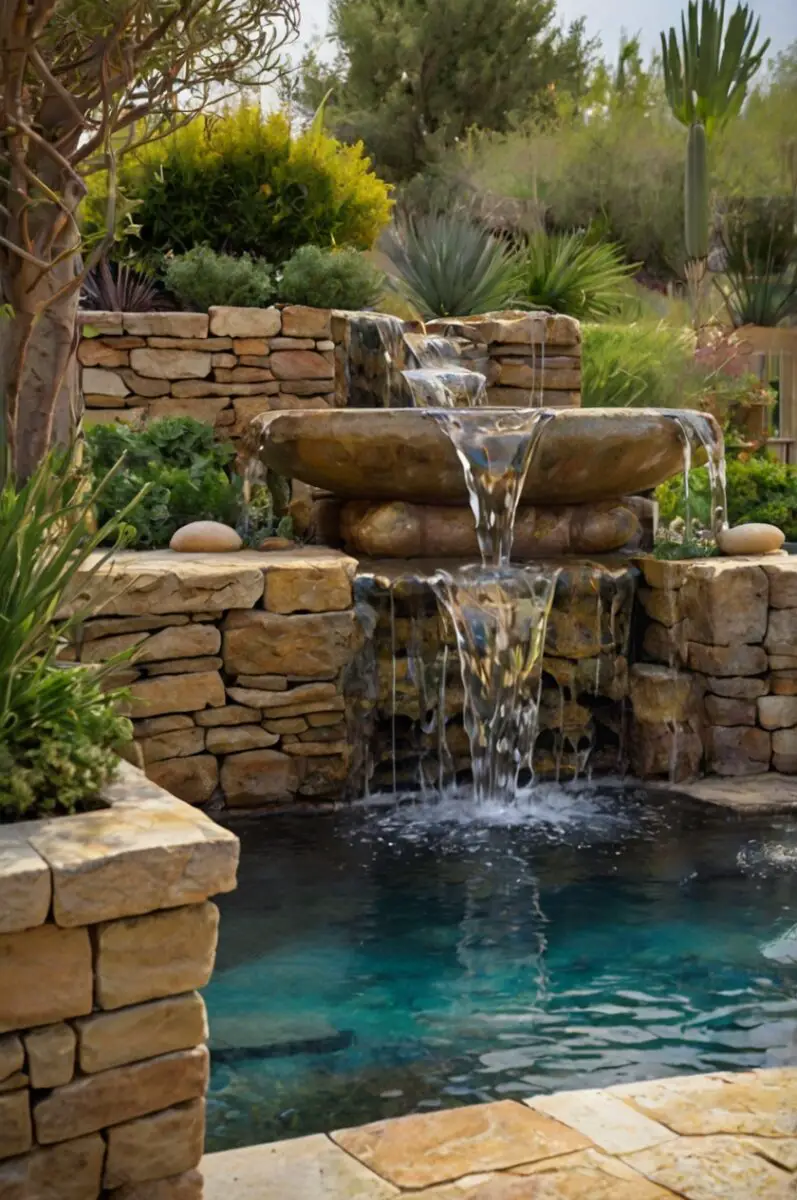
Water features bring cooling sounds and visual appeal while serving as natural gathering spots that enhance the Mediterranean atmosphere of your garden.
Select a location that’s visible from multiple vantage points in your yard but positioned away from overhead trees that might drop leaves and debris into the water.
Choose natural stone materials like limestone, sandstone, or slate that complement your existing hardscape and create authentic Mediterranean character.
Design your water feature to incorporate multiple levels or tiers that create interesting water flow patterns and appealing sound variations.
Install a recirculating pump system that keeps water moving continuously, preventing stagnation while creating the soothing sounds of flowing water.
Surround your water feature with appropriate plantings that thrive in the increased humidity – ferns, hostas, or moisture-loving perennials that contrast beautifully with drought-tolerant Mediterranean plants.
Add aquatic plants like water lilies, lotus, or floating hyacinth that provide natural filtration while creating beautiful blooms and foliage.
Include underwater lighting that illuminates your water feature during evening hours, creating magical reflections and extending the visual impact into nighttime.
Position comfortable seating nearby where you can fully appreciate the sight and sound of moving water while relaxing or entertaining guests.
Integrate your water feature with existing hardscape elements like retaining walls, pathways, or patio edges for a seamless, planned appearance.
Add decorative elements like pottery, sculptures, or carefully placed boulders that enhance the Mediterranean aesthetic without overwhelming the natural beauty.
Ensure easy access for maintenance while keeping utility connections hidden behind plantings or decorative screening that preserves the natural appearance of your water feature.
TRENDING NOW
13 Backyard Remodel Ideas For a Stunning OasisDesign Outdoor Dining Areas with Mediterranean Flair
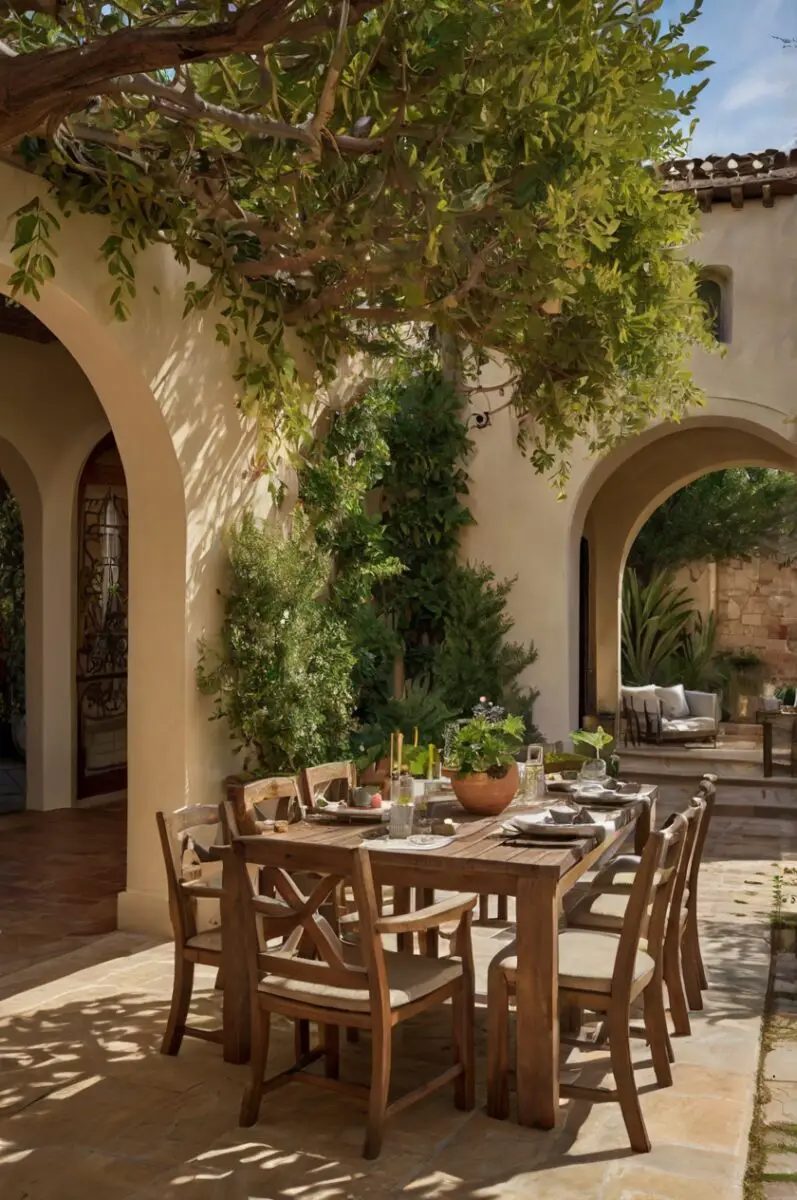
Create inviting outdoor dining spaces that capture the leisurely pace and social atmosphere characteristic of Mediterranean living.
Choose a location that receives morning sun but offers afternoon shade, either from existing trees, structures, or planned pergolas and umbrellas.
Select furniture materials that withstand outdoor conditions while maintaining authentic Mediterranean style – wrought iron, teak, or weather-resistant wicker in natural tones.
Install permanent features like built-in stone benches, fire tables, or outdoor kitchens that anchor your dining area and provide year-round functionality.
Create intimate lighting using string lights, lanterns, or torches that provide warm illumination perfect for evening meals and conversations.
Plant aromatic herbs like rosemary, lavender, and thyme around your dining area where their fragrances can be enjoyed during meals.
Add privacy screening using tall plantings, decorative screens, or trellises covered with climbing vines that create enclosure without feeling cramped.
Include storage solutions like built-in cabinets, weatherproof containers, or nearby sheds where you can keep cushions, tableware, and entertaining supplies protected.
Position your dining area near outdoor cooking facilities, whether that’s a built-in grill, pizza oven, or simple portable barbecue for convenient meal preparation.
Create windbreaks using plantings, walls, or screens that protect diners from prevailing breezes while maintaining good air circulation.
Add comfortable textiles like outdoor rugs, cushions, and table linens in Mediterranean colors – blues, whites, terracottas, and warm yellows that enhance the ambiance.
Include serving areas like side tables, bar carts, or built-in counters that provide convenient surfaces for food and beverages during outdoor entertaining.
Establish a Mediterranean Color Palette Garden
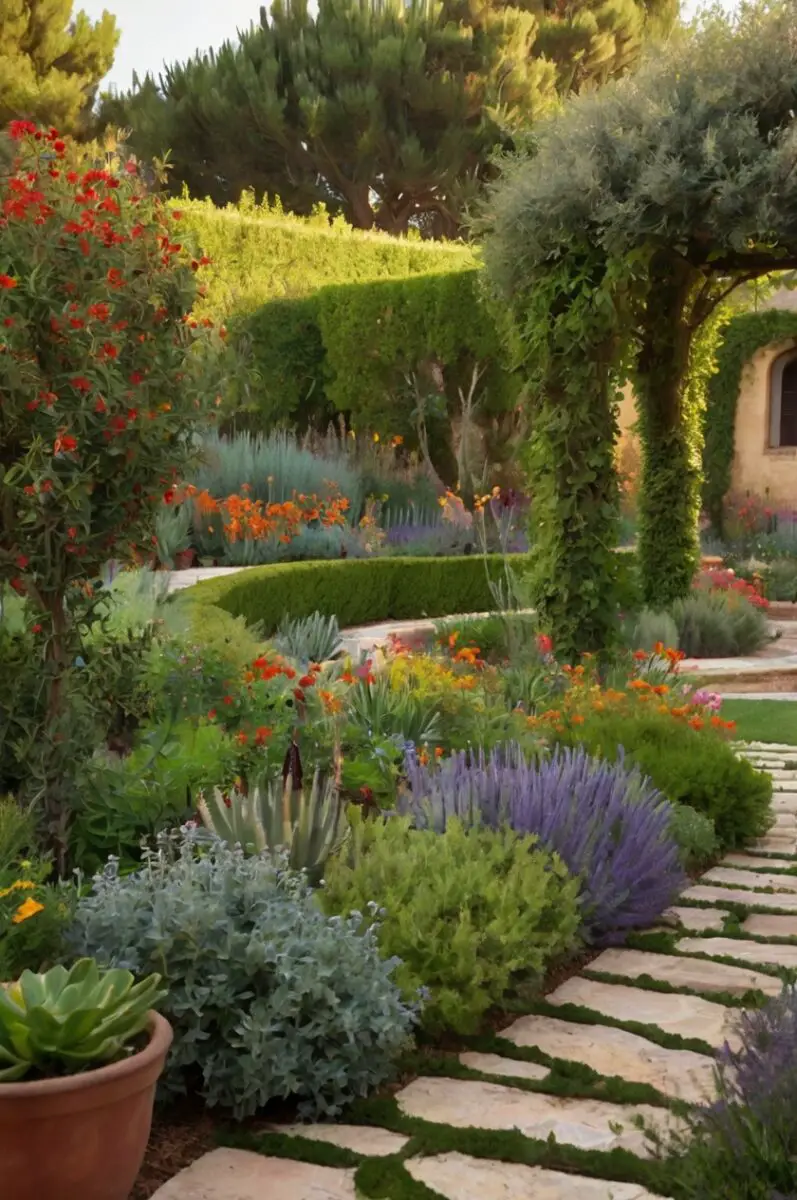
Develop a cohesive color scheme that reflects the warm, sun-drenched hues characteristic of Mediterranean landscapes and architecture.
Start with a foundation of silvery-gray foliage plants like lavender, dusty miller, and lamb’s ear that provide neutral backgrounds for more vibrant blooms.
Incorporate warm earth tones through your hardscape choices – terracotta pots, sandstone pathways, and warm-toned gravel that ground your color palette.
Add pops of brilliant blue through plantings like agapanthus, plumbago, or Russian sage that echo the Mediterranean sea and sky.
Include sunny yellow accents with plants like coreopsis, rudbeckia, or golden oregano that bring warmth and cheerfulness to your garden beds.
Plant white-flowering varieties like jasmine, gardenias, or white roses that provide cooling contrast and elegant sophistication throughout the growing season.
Use purple and lavender tones extensively through plants like catmint, salvia, and actual lavender varieties that create soothing, aromatic drifts of color.
Incorporate warm orange and red accents sparingly through plants like bougainvillea, hibiscus, or nasturtiums that add excitement without overwhelming the palette.
Choose container plantings in complementary colors – blue ceramic pots, terracotta urns, or weathered metal planters that enhance rather than compete with your plants.
Add seasonal interest through bulbs and annuals that maintain your color scheme while providing changing displays throughout the year.
Include architectural elements like painted walls, decorative tiles, or colored concrete that reinforce your chosen palette and tie disparate elements together.
Balance warm and cool tones throughout your space, using warmer colors in sunny areas and cooler tones in shadier spots for optimal visual harmony.
Incorporate Drought-Tolerant Native Mediterranean Plants
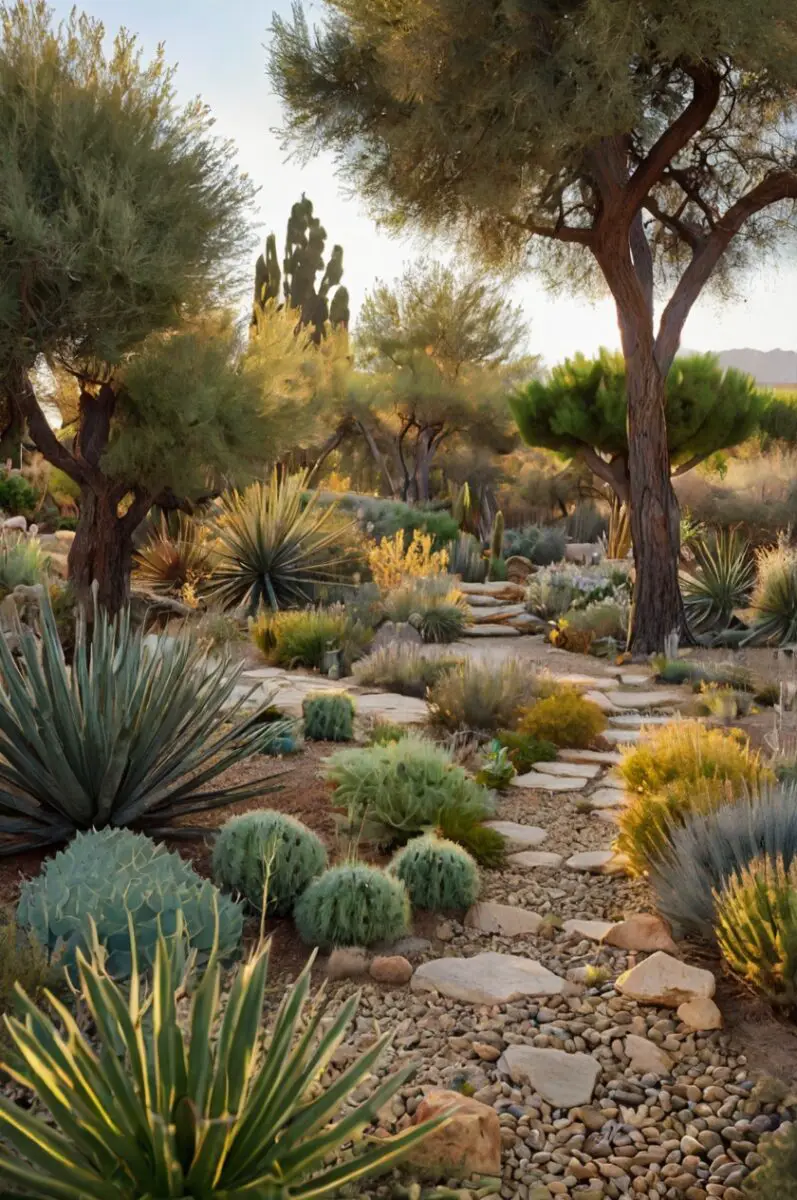
Build a sustainable garden foundation using plants naturally adapted to Mediterranean climates that require minimal water and maintenance once established.
Research native plants specific to your region that share characteristics with traditional Mediterranean species – similar water needs, sun requirements, and soil preferences.
Group plants with similar water requirements together, creating hydrozones that allow you to tailor irrigation and care to specific plant needs.
Include structural evergreen plants like rosemary, sage, and lavender that provide year-round interest while requiring minimal supplemental watering.
Add deciduous varieties like pomegranate, fig, or grape that provide seasonal change and potential food production while maintaining drought tolerance.
Plant ornamental grasses like fountain grass, blue fescue, or Mediterranean spurge that add movement, texture, and low-maintenance beauty to your landscape.
Include succulent varieties like agave, aloe, or sedum that store water in their tissues and provide striking architectural forms with minimal care requirements.
Choose flowering perennials like catmint, salvia, or rock rose that provide long blooming seasons while attracting beneficial pollinators to your garden.
Plant groundcover varieties like thyme, oregano, or trailing rosemary that suppress weeds while providing aromatic carpets of foliage and flowers.
Add bulbs like alliums, tulips, or daffodils that naturalize over time and provide early season color before summer heat arrives.
Include small trees like olive, citrus, or Mediterranean pine that provide structure, shade, and potential harvests while maintaining drought tolerance.
Mulch heavily around all plantings with organic materials like bark chips or gravel that conserve soil moisture and suppress weed growth while maintaining the Mediterranean aesthetic.
Create Cozy Seating Nooks with Privacy Screening
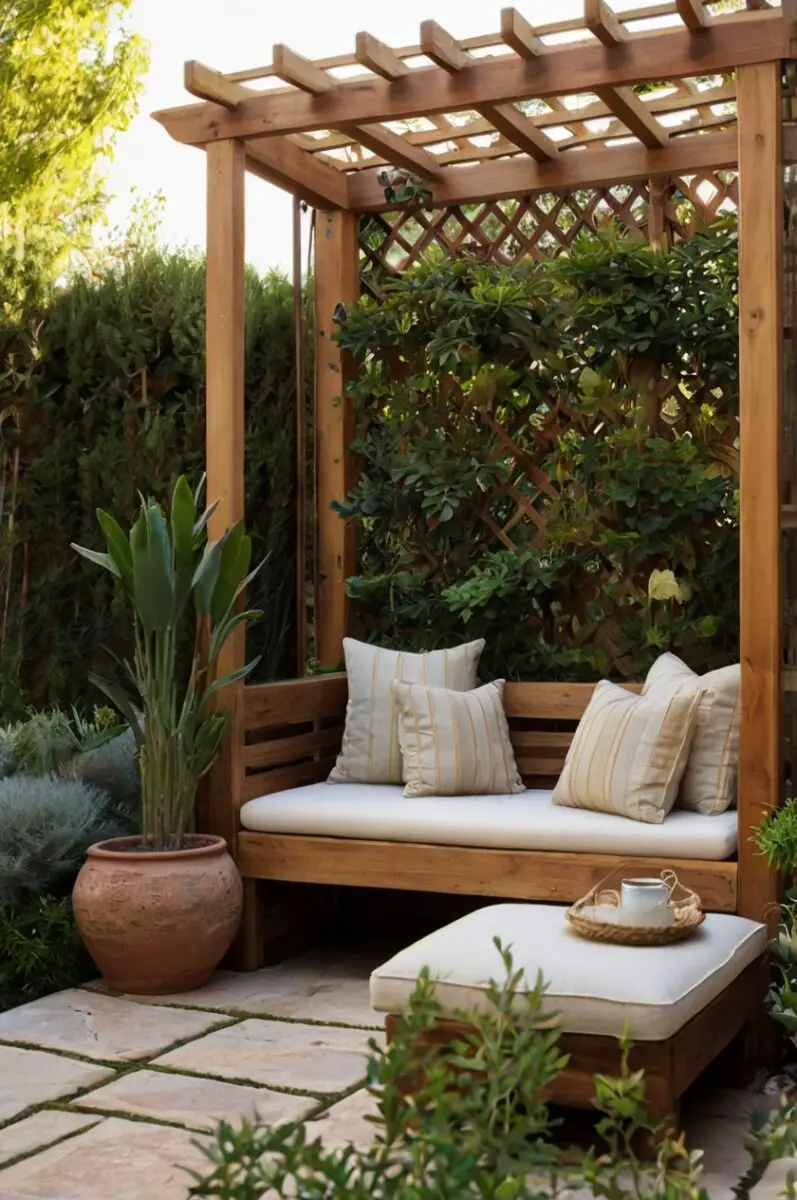
Design intimate seating areas throughout your garden that provide comfortable retreats for reading, conversation, or quiet contemplation.
Position seating nooks in naturally sheltered locations like corners, against walls, or beneath existing trees where they feel protected and enclosed.
Use a combination of permanent and temporary privacy screening – planted hedges, decorative screens, or strategically placed containers that can be adjusted as needed.
Choose comfortable, weather-resistant seating options like built-in stone benches, teak chairs, or weather-resistant cushions that invite extended use.
Add soft furnishings like outdoor pillows, throws, and small tables that enhance comfort while maintaining the Mediterranean aesthetic through color and material choices.
Include task lighting like solar lanterns, battery-operated sconces, or string lights that allow evening use without requiring electrical installation.
Plant aromatic varieties around seating areas where their fragrances can be enjoyed up close – jasmine, gardenias, or herb plantings that engage the senses.
Create windbreaks using plantings, screens, or built structures that protect seating areas from prevailing breezes while maintaining good air circulation.
Add storage solutions like weatherproof containers, built-in compartments, or nearby sheds where cushions and accessories can be protected when not in use.
Include side tables, plant stands, or other surfaces where beverages, books, or personal items can be placed conveniently within reach.
Design multiple seating areas throughout your garden to accommodate different times of day, activities, or group sizes for maximum flexibility and enjoyment.
Position seating to take advantage of garden views, water features, or other focal points that enhance the experience of spending time in your outdoor spaces.
TRENDING NOW
Unlock Amazing Free Gardening Container HacksInstall Decorative Pathway Systems
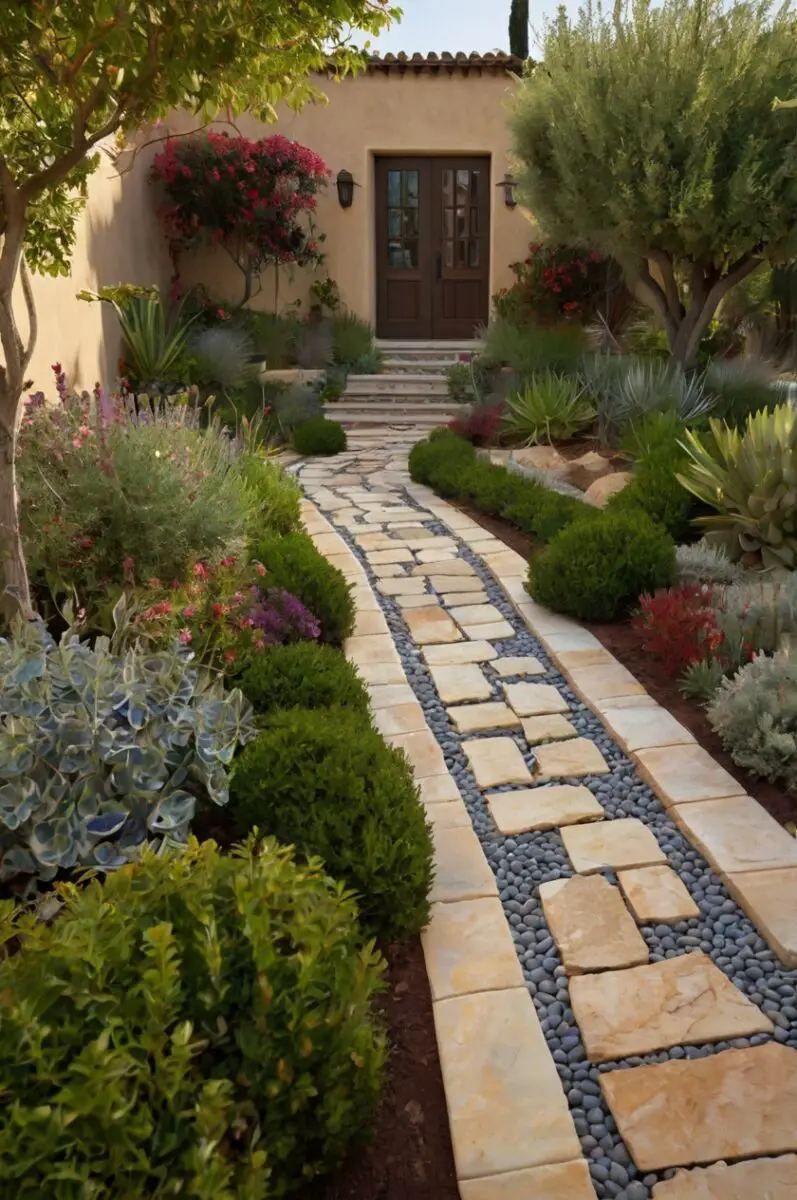
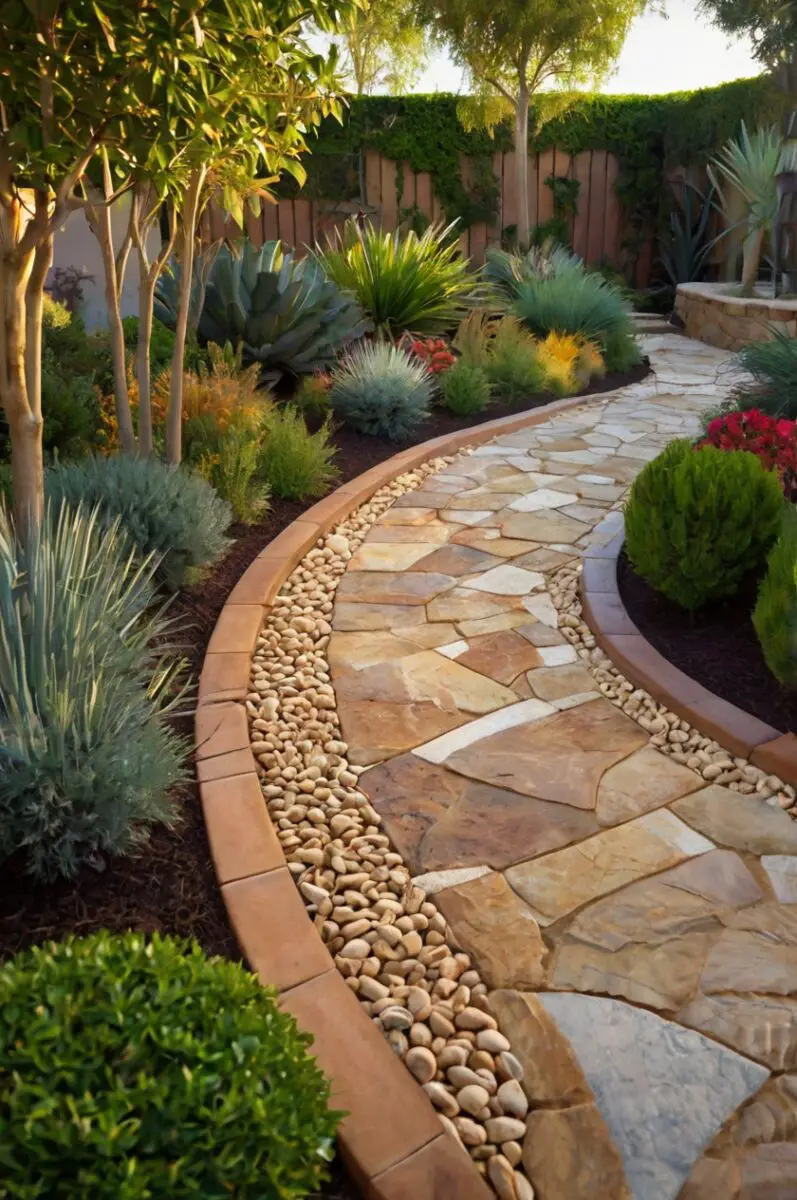
Create beautiful walkways that connect different areas of your garden while adding visual interest and guiding movement through your outdoor space.
Choose pathway materials that complement your home’s architecture and existing hardscape – natural stone, brick, decomposed granite, or gravel in warm Mediterranean tones.
Design curved pathways that encourage leisurely strolling and create opportunities to discover different garden areas rather than direct, utilitarian routes.
Vary pathway widths to create visual interest and accommodate different functions – wider areas for gathering and conversation, narrower sections for intimate passage.
Edge your pathways with appropriate border materials like stone, brick, or metal strips that prevent material migration while creating clean, finished appearances.
Plant pathway borders with low-growing, aromatic varieties like thyme, oregano, or lavender that release fragrances when brushed against during passage.
Install pathway lighting using solar fixtures, low-voltage LED strips, or strategically placed lanterns that provide safe navigation during evening hours.
Create destination points along your pathways like seating areas, water features, or specimen plantings that reward progress and encourage exploration.
Include stepping stones through planted areas where full pathways aren’t necessary but occasional access is needed for maintenance or harvesting.
Add decorative elements like mosaic inlays, carved stones, or pottery shards that personalize your pathways while maintaining Mediterranean character.
Ensure proper drainage alongside pathways to prevent erosion and pudding that could damage both the walkway and surrounding plantings.
Plan pathways to connect all major garden areas including seating spaces, dining areas, water features, and utility areas for functional access throughout your landscape.
Mediterranean garden design offers endless opportunities to create beautiful, functional outdoor spaces that capture the essence of coastal European living.
These ideas provide starting points for transforming your yard into a personal paradise that reflects the timeless appeal of Mediterranean style.
Start with one or two concepts that speak to you most strongly, then gradually expand your vision as your garden matures and your confidence grows.

